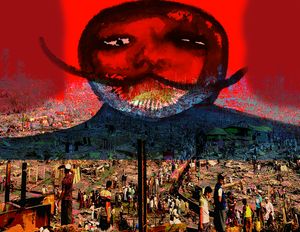Even as the western and northern borders are getting more attention, a sort of quiet has descended on the country’s eastern border—especially with Myanmar, which was rocked by a military coup earlier this year. An undeclared arrangement has been put into place regarding the refugees who fled to Mizoram after the military crackdown on the government of Aung San Suu Kyi, which put her and the entire government behind bars.
The refugees, whose number varies between 6,000 and 10,000, would stay put in Mizoram and Manipur, but they would not indulge in any political activity. However, India would not immediately concede the demand of the military junta to hand over the local legislators, policemen and army deserters who crossed the border soon after the coup. While New Delhi will not allow formal refugee camps, it would not stand in the way of humanitarian aid coming from the state governments and local population, who share the same ethnicity with most refugees who are from the Chin State in western Myanmar.
The United States and European countries have been putting pressure on the Narendra Modi government to be more forthright in condemning the coup and even impose sanctions. But the prime minister, who has refocused the Look East policy, has opted for continuity of his policy which defenders say is pragmatic and critics attack as kowtowing. The Indian stand of demanding an end to violence and release of political prisoners is the same as the stand of the Association of Southeast Asian Nations (ASEAN) of which Myanmar is a member. India abstained from a vote in the United Nations which aimed at isolating the military junta, even though both the Indian military and intelligence agencies are more concerned about the larger Chinese involvement in the eastern neighbour with which India shares a 1,600km border. The cabinet committee of security has met several times to discuss the situation in Myanmar and its impact on the northeast.
The military has deployed the Assam Rifles in a bigger way to prevent a large-scale influx of refugees. But both home and external affairs ministries are not in favour of allowing international refugee agencies to visit or make arrangements in the sensitive border states. Only a handful of Myanmarese activists—who got a court order—were permitted to visit the UN High Commissioner for Refugees office in Delhi, but they were quietly told to avoid making a political show.
The Indian embassy in the Myanmar capital Naypyidaw has conveyed the government’s concern over the violence and detentions, while adding New Delhi’s hopes for a return to the democratic traditions of a country that has had long spells of military rule since its independence. But during the six years of rule of Suu Kyi’s National League for Democracy, which ran parallel to the rule of Modi, India has dealt with both the civilian government and the military in a nuanced way. Like China, Russia and several East Asian countries, New Delhi, too, ensured that the two power partners were given necessary recognition, even as Myanmar came out of the crippling sanctions imposed earlier by the US and European Union.
This also ensured the support of the Myanmar military in containing northeast separatist groups operating across the border. As earlier history has shown, democratic change is slow in Myanmar. So, India has always shown patience, except from 1988 to 1993. During this period, the country had four prime ministers and the foreign policy tilted more towards the pro-democracy movement. But the compulsions of internal security made the fourth one among these prime ministers—P.V. Narasimha Rao—adopt a more nuanced approach. This policy still perseveres.
sachi@theweek.in


